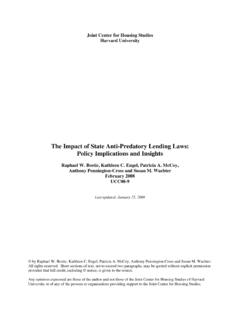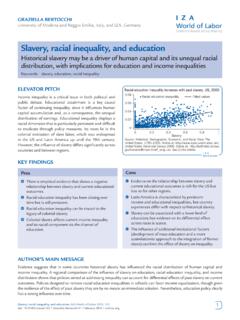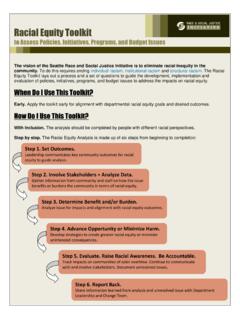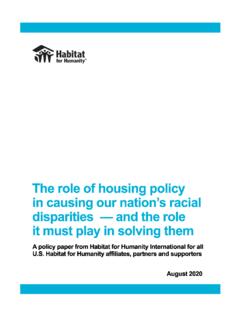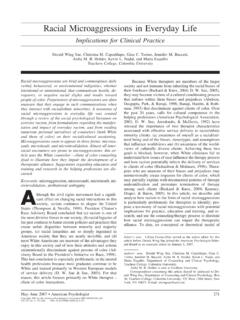Transcription of THE INGREDIENTS OF EQUITABLE DEVELOPMENT …
1 THE INGREDIENTS OF EQUITABLE DEVELOPMENT PLANNINGA Cross-case Analysis of EQUITABLE DEVELOPMENT Planning and CDFIsJOINT CENTER FOR HOUSING STUDIES OF HARVARD UNIVERSITYJOINT CENTER FOR HOUSING STUDIES OF HARVARD UNIVERSITYHARVARD GRADUATE SCHOOL OF DESIGNHARVARD KENNEDY SCHOOL Principal funding for this report was provided by JPMorgan Chase & photo credit: Destination DCInside front cover photo credit: Becky Harlan 2019 by the President and Fellows of Harvard opinions expressed in this PRO Neighborhoods report do not necessarily represent the views of Harvard University or JPMorgan Chase & von Hoffman is a senior research fellow at the Joint Center for Housing Studies and lecturer at the Harvard Graduate School of author is indebted to all the practitioners and experts for sharing their experiences and views; to Matthew Arck for data and graphics research, photographs, and descriptions of awardees.
2 To Mary Bogle for thoughtful comments about a draft version of this report, to David Luberoff for editorial insights, and to Christopher Herbert and Mary Lancaster for their advice and guidance. TABLE OF CONTENTSEXECUTIVE SUMMARY ..5 INTRODUCTION ..7 EMERGENCE OF THE EQUITABLE DEVELOPMENT CONCEPT ..8 Historical Roots ..8 Collective Impact ..12 Cases of EQUITABLE DEVELOPMENT Planning with CDFIs ..13 LARGE-SCALE EQUITABLE DEVELOPMENT PRO NEIGHBORHOODS AWARDEES ..14 PRO NEIGHBORHOODS AWARDEES WITH EQUITABLE DEVELOPMENT FEATURES ..15TO BEGIN EQUITABLE DEVELOPMENT ..16 Urban Environments ..16 Origins ..18 Leadership ..19 Target Geographies ..20 SETTING THE AGENDA.
3 23 Different Routes to the Plan ..23 Technical Expertise and Community Knowledge ..24 Acquiring Knowledge through Data ..26 FINANCING EQUITABLE DEVELOPMENT ..29 The Incremental Model ..29 The Civic Consortium Model ..30 MODES OF IMPLEMENTATION ..33 The Necessity of Collaborations ..33 Quarterbacks to Run the Team ..33 Experienced Partners ..34 CDFIs - Deploying Capital for EQUITABLE DEVELOPMENT ..35 LESSONS FOR THE FUTURE OF EQUITABLE DEVELOPMENT ..38 JOINT CENTER FOR HOUSING STUDIES OF HARVARD UNIVERSITY | 3 WASHINGTON, D .C .DETROIT, MICHIGANPHOENIX, ARIZONAIn the growing Sunbelt, the revitalizing Rustbelt, and on the booming coasts, local communities and governments are working together to ensure that DEVELOPMENT benefits residents of all backgrounds and credits: Valley Metro Regional Public Transportation Authority; Matthew Arck4 | JOINT CENTER FOR HOUSING STUDIES OF HARVARD UNIVERSITYEXECUTIVE SUMMARYE quitable DEVELOPMENT is a new form of community DEVELOPMENT and urban planning aimed at revitalizing disinvested communities and ensuring that all residents of urban places can shape urban DEVELOPMENT and benefit from economic growth in an EQUITABLE fashion.
4 This report analyzes three current EQUITABLE DEVELOPMENT campaigns in Washington, ; Detroit, Michigan; and Phoenix, Arizona involving nonprofit community DEVELOPMENT financial institutions (CDFIs) that received awards from JPMorgan Chase & Co. as part of its Partnerships for Raising Opportunity in Neighborhoods (PRO Neighborhoods) recent experiences of these efforts offer key preliminary lessons, including the following: The form that EQUITABLE DEVELOPMENT takes must reflect the prevailing social and economic conditions in each locale. Opportunity to start an EQUITABLE DEVELOPMENT project may arise from a catalytic event such as the undertaking of a large infrastructure project or a broad civic campaign.
5 Leaders of EQUITABLE DEVELOPMENT campaigns should possess great enthusiasm for pursuing EQUITABLE DEVELOPMENT goals, the ability to adapt to circumstances, a willingness to consult with experts, and great patience. EQUITABLE DEVELOPMENT planners should draw target-area boundaries by first studying and assessing local conditions. Setting an agenda of general and specific goals must begin with learning the wishes and needs of community residents. EQUITABLE DEVELOPMENT planners should engage the community as early as possible. EQUITABLE DEVELOPMENT requires accurate and relevant data from the first to the last what gets measured gets done! Obtaining seed capital is critical to an EQUITABLE DEVELOPMENT effort in its infancy.
6 To find funding for EQUITABLE DEVELOPMENT , leaders may take the -incremental approach of gradually building support and acquiring backers, or -the civic consortium approach, of partnering within an existing network of funders and agencies in a large-scale civic campaign. The diverse nature of EQUITABLE DEVELOPMENT requires different types of organizations to collaborate with one another to achieve complementary goals. Organizations that have worked with each other in the past are more likely to form effective collaborations. One organization with the capacity to do so should lead and coordinate the effort. In an EQUITABLE DEVELOPMENT campaign, CDFIs can play the roles of quarterback organization, lead financier, and/or community partner, as well as fill valuable transactional CENTER FOR HOUSING STUDIES OF HARVARD UNIVERSITY | 5 Although a relatively new concept, EQUITABLE DEVELOPMENT holds great promise as a form of planning and community DEVELOPMENT that can make communities of low- and moderate-income and minority people into places that provide economic opportunities, affordable living, and cultural expression for all residents.
7 Bringing about EQUITABLE DEVELOPMENT , however, is a complicated endeavor. EQUITABLE DEVELOPMENT efforts have absorbed the techniques of several important past movements for social improvement, including equity planning, place-based and comprehensive community DEVELOPMENT , people-based asset building, smart growth and sustainable schools of regional planning, and the collective impact collaborative model of social action. Applying the panoply of such techniques requires extraordinary commitment, persistence, flexibility, and organizational sophistication. The elements for successfully mobilizing forces for EQUITABLE DEVELOPMENT , this study shows, include seizing opportunities from large civic endeavors, choosing skilled leaders, tapping sympathetic experts, utilizing relevant data, and systematically engaging community residents.
8 Successful efforts entail creating a collaboration of organizations and government agencies and then coordinating these entities to function effectively for a wide range of EQUITABLE DEVELOPMENT the newness of the EQUITABLE DEVELOPMENT movement, it will be critical for its practitioners to continue to use data to assess the accomplishments and shortcomings of their projects and programs in the years to the present, it is worth noting that despite the daunting challenges faced by their leaders, current EQUITABLE DEVELOPMENT projects reveal an exciting potential for shaping living environments that benefit people of all backgrounds and conditions. In 2017 Building Bridges Across the River in Washington, D.
9 C., worked with local communities of faith and nonprofit organizations and some 250 volunteers to build and cultivate six Bridge Park Plots for growing healthy credit: Becky HarlanBRIDGE PARK COMMUNITY GARDENSINTRODUCTION experiences of several entities that are putting this new approach into practice today. These sections examine the origins and first steps of EQUITABLE DEVELOPMENT efforts; the essential keys to setting an agenda to change an urban environment; approaches to financing EQUITABLE DEVELOPMENT ; and modes of organizational implementation. Within each section are sub-sections devoted to different aspects of the main topic, which are followed by a set of preliminary lessons or take-aways for report is based on interviews with practitioners, publications on planning and EQUITABLE DEVELOPMENT , and reviews of scholarly articles, reports, and other accounts.
10 In particular, the report draws on three current and ongoing campaigns for EQUITABLE DEVELOPMENT , including collaborative efforts that received awards from the Partnerships for Raising Opportunity in Neighborhoods (PRO Neighborhoods) program. This program, which was launched by JPMorgan Chase & Co. in 2013, awards three-year grants to groups of community DEVELOPMENT financial institutions (CDFIs) that form innovative partnerships to enhance opportunities for low- and moderate-income Americans and to revitalize distressed neighborhoods. As such, the cases examined here involve CDFIs, and the report addresses the potential of these nonprofit lending organizations to deploy capital in the cause of EQUITABLE a time of extreme inequality of income in the United States, many leaders in the nonprofit, public, and philanthropic sectors are looking to EQUITABLE DEVELOPMENT as a way to revitalize disinvested communities and help their low-income residents, especially in places where soaring real estate values threaten to displace existing low-income households and/or prevent new ones from moving in.



